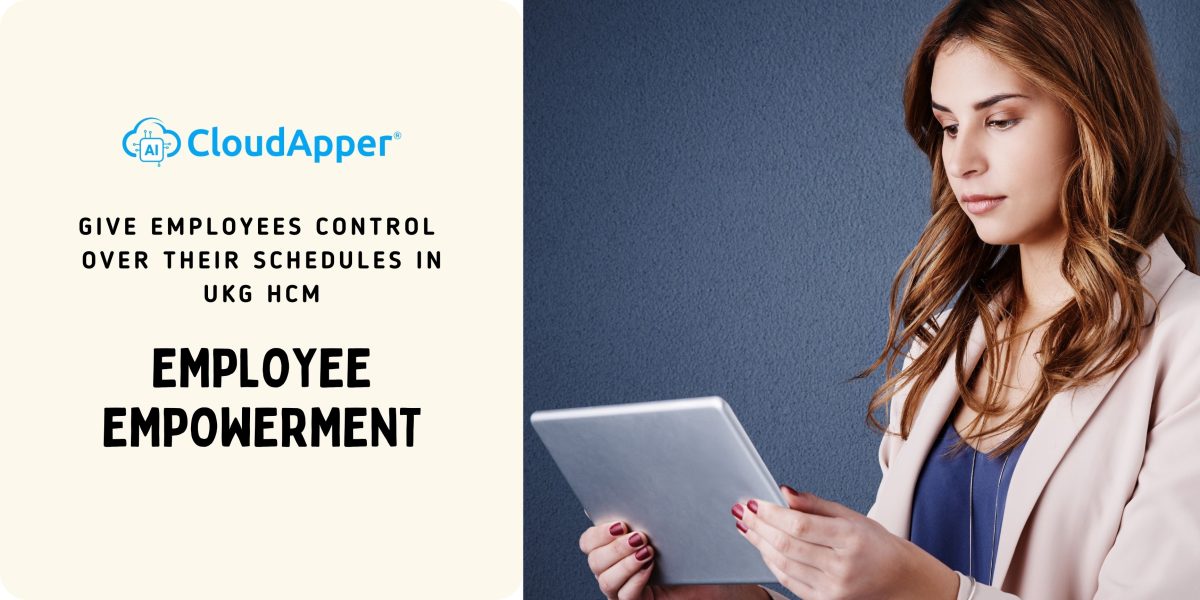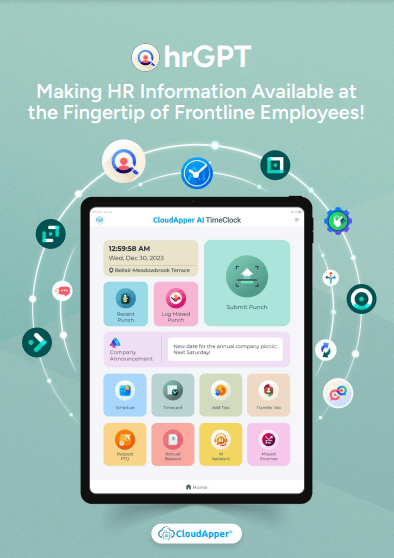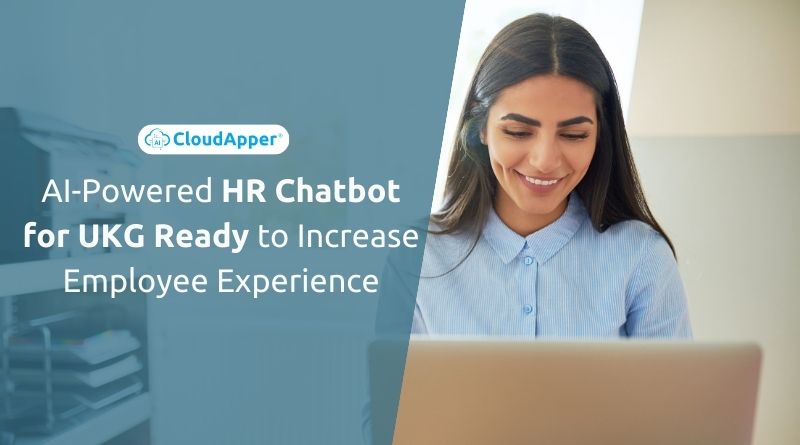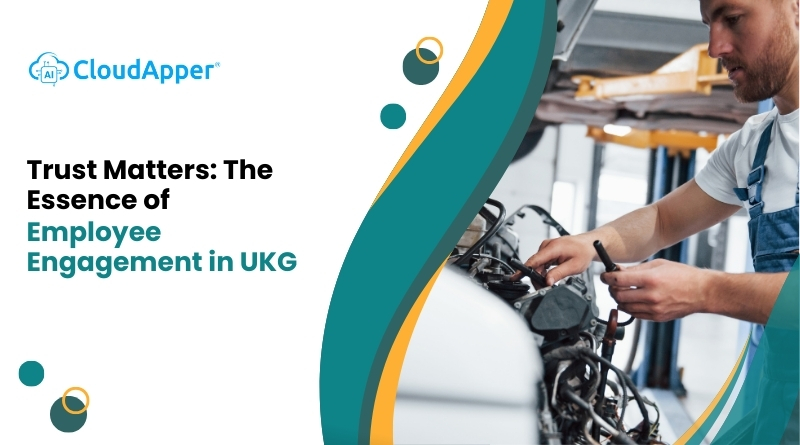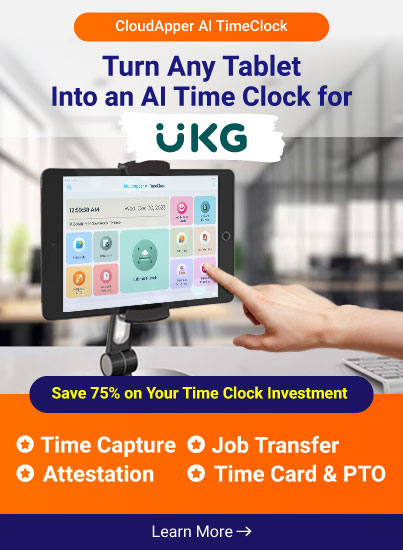Table of Contents
Because of the fast-paced nature of modern workplaces, human resource managers now prioritize employee involvement and happiness. Changing the game in this aspect would be allowing for more freedom in determining work hours. But is there a way to simplify this step in HR administration? Human resource management will be revolutionized with the help of CloudApper AI TimeClock and hrGPT for those who utilize UKG HCM (Ultimate Kronos Group) products including Pro, Ready, and Dimensions.
Discover how empowering your employees to schedule their own shifts with CloudApper AI TimeClock and hrGPT may lead to cost savings, improved efficiency in human resources, and a more positive experience for everyone involved.
The Shift Towards Employee Empowerment
Historically, workers have had little influence over when they actually clock in and out. Shifts were assigned based on the discretion of HR managers and supervisors, leaving little flexibility for individual preferences and work-life harmony. However, there has been a significant shift in the way modern labor operates. Today’s workers want more leeway in their schedules so they may better balance their professional and personal lives and devote their full talents to their jobs.
To recruit and keep the best employees, several companies are implementing policies that put more authority in the hands of their workers. Employees who are given greater discretion over their work schedules report feeling more invested in their jobs, as well as more content and productive. Because of this, turnover is decreased and morale is increased, both of which are beneficial to the company’s bottom line.
The Role of CloudApper AI TimeClock
When it comes to enabling workers, CloudApper AI TimeClock becomes an essential tool. HR decision-makers like the solution’s adaptability and ease of use, as well as the many advantages it provides when integrated with UKG HCM solutions.
1. Streamlined Time Tracking
Effective time management skills are a cornerstone of a self-managing workforce. With CloudApper AI TimeClock, employees can easily clock in and out from their iOS or Android tablets, streamlining the time tracking process. This standardizes procedures, cuts down on paperwork, and guarantees reliable attendance statistics.
2. Real-time Access to Schedules
To really empower workers, though, you must provide them access to their schedules in real time. Self-service capabilities in CloudApper AI TimeClock allow employees to Kronos time clock sign in, check their schedules, see when their next shift is, and even request time off. Trust and participation are bolstered by this openness.
3. Mobile Workforce Management
CloudApper AI TimeClock’s geofencing and geolocation monitoring features let employers verify that workers are present at their designated clocking points in an increasingly distant and mobile workforce. Companies with mobile or distributed staff will find this function particularly useful.
4. Cost Savings
When compared to conventional timekeeping methods, CloudApper AI TimeClock is far more cost-effective. The cloud-based technology removes the need for expensive time clock hardware and the associated maintenance costs. A cheap monthly membership fee makes it possible for businesses of any size to afford it.
5. Enhanced Compliance
Observance of labor standards and statutes is essential. The automatic time monitoring and reporting tools available in CloudApper AI TimeClock make it easy for HR departments to uphold compliance standards. This not only lessens the potential for noncompliance, but also prevents the waste of time and money that would be required for compliance audits and fixes.
Empowering Employees with hrGPT
Even while CloudApper AI TimeClock is ahead of the curve when it comes to scheduling and tracking employee time, the true potential of employee empowerment goes well beyond simple punching a clock. Here comes hrGPT, an AI analyst available around the clock for all your HR needs and questions. When used in tandem with CloudApper AI TimeClock, this AI-powered assistant improves the employee experience while also streamlining administrative tasks.
1. Personalized HR Data Access
With hrGPT, getting at your own unique HR data is a breeze. Schedules, vacation days, perks, and more may all be easily accessed by staff members. In this way, workers may get their questions answered without having to contact HR as often.
2. Automated Self-service Workflows
With the help of hrGPT, it is possible to eliminate inefficiencies and save expenses in HR procedures. It streamlines self-service workflows so workers can easily submit requests for time off, change their contact information, and inquire about their benefits. This not only improves productivity but also gives workers more agency in addressing their own human resources concerns.
3. Round-the-clock Support
hrGPT’s accessibility at any time of day or night is a major selling point. hrGPT is available 24/7 to help with everything from basic policy questions to urgent requests for time off. This makes HR resources more convenient for workers in different time zones.
4. Reduced HR Workload
Getting rid of unnecessary paperwork is a top priority for human resources managers. By streamlining and automating menial HR processes, hrGPT allows HR professionals to devote their attention to more high-level goals and issues. As a result, HR productivity rises while operational expenses fall.
The Bottom Line: A Win-Win Scenario
Adding CloudApper AI TimeClock and hrGPT to your existing UKG HCM ecosystem is a win-win situation for everyone involved. As a result, workers are happier in their roles since they can better manage their time and have easier access to HR resources. Human resources managers, on the other hand, get the rewards of a more productive, engaged, and cost-efficient staff.
Employee empowerment is becoming more than just a term in today’s rapidly changing company environment; it’s a strategic need. CloudApper AI TimeClock and hrGPT provide us the means to make this dream a reality. Organizations can unleash their full workforce potential and boost productivity by giving workers more say over their work schedules and human resources-related duties.





